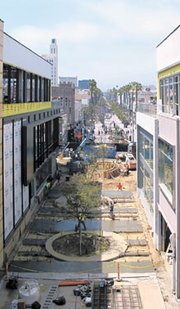Mall Biz Grows During Recession
The mall industry grew slightly during the recession, according to a study released May 23 by the International Council of Shopping Centers (ICSC), but the tough economy drastically scaled back traditional mall development and is encouraging malls to experiment with the anchor concept.
Despite the economic battering of the Great Recession, the number of American shopping centers inched up slightly in 2010 to 104,990 malls, compared with 104,919 in 2009, according to the study, authored by CoStar Group and ICSC and released at The Global Retail Real Estate Convention, held May 23–25 in Las Vegas.
It was the slowest growth in mall development since 1971. However, the retail real estate business showed improvement through tough times, according to ICSC Chief Economist Michael Niemira.
And as the mall business adapted to the bruising recession, mall owners stopped playing by the old rulebook, according to the ICSC.
“There’s not a lot of new development going on,” said Jesse Tron, an ICSC spokesperson. The last traditional, enclosed mall constructed in America was The Mall at Turtle Creek, completed in 2006 in Jonesboro, Ark., he said.
“The real trend is redevelopment,” Tron continued. “When people get credit and capital, they are reinvesting in their properties. It’s been that way throughout the course of the recession, and we’re going to see that throughout the year.”
Some of the biggest shopping-center development stories in California have made headlines as redevelopment projects. The Fashion Valley mall, owned by Simon Property Group Inc., announced the renovation of its 1.7 million-square-foot space in San Diego County, which is scheduled to wrap up in September 2011.
Fashion Valley is the address of high-profile boutiques such as Hermegrave;s and Burberry as well as fast-fashion retailer Forever 21 and hosts anchors such as Bloomingdale’s, Macy’s, JCPenney and Neiman Marcus. By the time its more than $15 million beautification process is over, the Fashion Valley mall will have a new paint job, new paving and flooring, new landscaping, new lighting and seating, and two new water fountains, said Bob Dougherty, the mall’s general manager.
New looks are expected to attract new crowds eager to check out a new angle at a favorite place. However, Dougherty explained that Simon financed the multi-million-dollar renovation because the luxury mall was overdue for a facelift. The last major renovation took place in 1997.
“This is a cosmetic renovation,” Dougherty said of Fashion Valley’s upcoming construction project. “There is no additional square footage, no physical changes for any of the buildings.”
Another big renovation project will make its debut on Aug. 6. Macerich Co. will unveil the $265 million renovation of the Santa Monica Place mall, which is adjacent to the high-profile Third Street Promenade retail district in Santa Monica, Calif.
However, Santa Monica Place’s general manager, Doug Roscoe, also calls the renovation a “re-imagining” of the mall, which was designed in 1980 by celebrated architect Frank Gehry.
Influential architect Jon Jerde redesigned the look of the mall. The roof was ripped off of the common areas of the mall. The three-story section of shops at the west end of Santa Monica Place will be covered by glass walls. The look of the 16,000-square-foot central court of the mall will be reminiscent of a sunny Italian piazza, with public art and fountains.Beyond the food court
One of the new Santa Monica Place’s biggest departures will be how the mall deals with restaurants and dining. The third level of the mall will be entirely devoted to restaurants.
“It’s more or less our third anchor,” Roscoe said of the more than six chef-driven restaurants on Santa Monica Place’s rooftop. Most of these restaurants, such as Xino Restaurant + Lounge and Zengo, have roots in the San Francisco Bay area. Also debuting will be a 14,000-square-foot farmers’ market, where independent producers of foods such as artisanal cheese will offer their goods. The space, called The Market, will open in November.
The third anchor of chef-driven restaurants and farmers’ markets is intended to attract more Santa Monica residents and crowds of office workers who make their living in Santa Monica, as well as tourists, Roscoe said.
The first two levels of Santa Monica Place will be devoted to fashion, footwear and accessories. Specialty retailers will include boutiques for brands Louis Vuitton, Ed Hardy, Coach, Michael Kors, Ted Baker and Betsey Johnson. Specialty retailer Kitson and affordable-fashion stores Love Culture and Angl also will put down stakes there. Department stores will include Nordstrom and Bloomingdale’s as well as a Barneys Co-op.
Restaurants and dining will increasingly command attention from mall owners, said Shaheen Sadeghi, owner of specialty retail centers The Camp and The Lab, both in Costa Mesa, Calif.
“We’re up double digits in restaurants,” Sadeghi said. “The customer may not be buying $200 jeans, but they are spending $150 for dinners.” In fact, Sadeghi’s two upcoming projects will be entirely devoted to restaurants and dining. Construction on Centennial Mills in Portland, Ore., is scheduled to begin in 2011. Sadeghi said the 200,000-square-foot space will feature a farmers’ market, cheese shops, wine boutiques and art galleries.
Sadeghi’s proposed Playa del Norte specialty retail center will host similar businesses. Sadeghi intends to build on a bluff above a beach in San Clemente, Calif. He will submit plans for the specialty center to the California Coastal Commission in July, and it might take up to 18 months for the commission to reach a decision approving plans for the center.



























